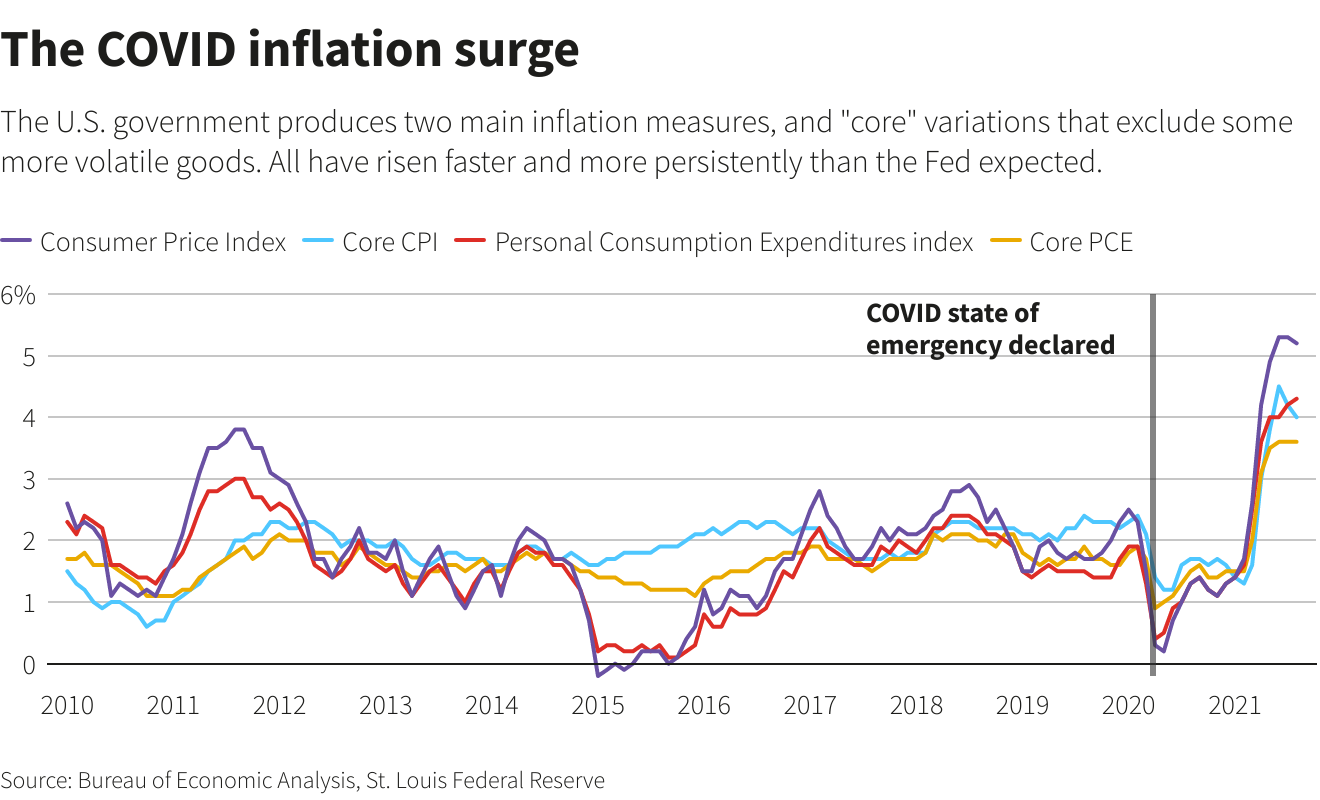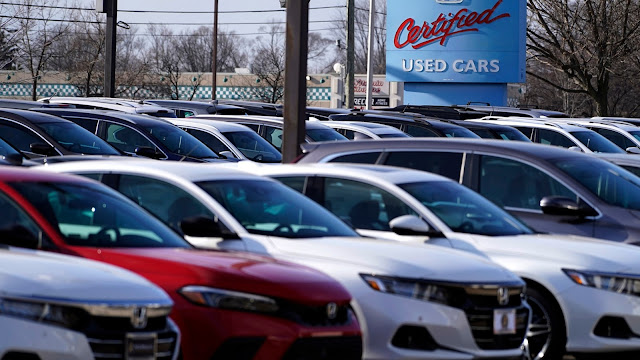U.S. consumer prices increased solidly in December as rental accommodation and used cars maintained their strong gains, culminating in the largest annual rise in inflation in nearly four decades, which bolstered expectations that the Federal Reserve will start raising interest rates as early as March.
The report from the Labor Department on Wednesday followed on the heels of data last Friday showing that the labor market was at or near maximum employment. Fed Chair Jerome Powell on Tuesday said the U.S. central bank stood ready to do what was necessary to keep high inflation from becoming "entrenched," in testimony during his nomination hearing before the Senate Banking Committee for a second four-year term as head of the bank.
The high cost of living, the result of snarled supply chains because of the COVID-19 pandemic, is a political nightmare for President Joe Biden, whose approval rating has taken a hit.
"The Fed is going to be forced to begin raising rates in March and depending on the political pressure on them – from both sides of the aisle – they are going to have to raise rates four or more times in this year and potentially more than that next year," said Chris Zaccarelli, chief investment officer at Independent Advisor Alliance in Charlotte, North Carolina.
The consumer price index rose 0.5% last month after advancing 0.8% in November. In addition to higher rents, consumers also paid more for food, though the 0.5% increase in food prices was less than in the prior three months. There were big gains in the prices of fruits and vegetables, but beef prices fell 2.0% after recent sharp gains.
Consumers also got a respite from gasoline prices, which fell 0.5% after rising 6.1% in both November and October.
In the 12 months through December, the CPI surged 7.0%. That was the biggest year-on-year increase since June 1982 and followed a 6.8% rise in November.
Economists polled by Reuters had forecast the CPI gaining 0.4% and shooting up 7.0% on a year-on-year basis.
Inflation is well above the Fed's flexible 2% target. It is also being lifted by budding wage pressures as the labor market tightens. The unemployment rate fell to a 22-month low of 3.9% in December. Money markets currently price about 85% odds of an interest rate hike by March. FED WATCH
Economists say the broad nature of inflation appears to have caught Fed officials off guard. There are concerns that inflation expectations could become entrenched and compel the Fed to aggressively tighten monetary policy, potentially causing a recession.
"This is the first time the Fed has chased instead of trying to preempt a nonexistent inflation since the 1980s," said Diane Swonk, chief economist at Grant Thornton in Chicago. "Brace yourselves."
Stocks on Wall Street were trading higher amid relief that the rise in prices was in line with expectations. The dollar fell against a basket of currencies. U.S. Treasury prices rose.

BOTTLENECKS EASING
Rising inflation is also eroding wage gains. Inflation-adjusted average weekly earnings fell 2.3% on a year-on-year basis in December.
Economists believe the year-on-year CPI rate probably peaked in December or will likely do so by March. There are signs that supply bottlenecks are starting to ease, with an Institute for Supply Management survey last week showing manufacturers reporting improved supplier deliveries in December.
But soaring COVID-19 cases, driven by the Omicron variant, could slow progress towards normalization of supply chains.
Excluding the volatile food and energy components, the CPI increased 0.6% last month after rising 0.5% in November.
The so-called core CPI was boosted by rents, with owners' equivalent rent of primary residence, which is what a homeowner would receive from renting a home, rising a solid 0.4% for a third straight month.
Prices for used cars and trucks accelerated 3.5% after increasing 2.5% in each of the prior two months. The surge likely reflects Hurricane Ida in late August and early September, which destroyed thousands of motor vehicles among other properties.
New motor vehicle prices rose 1.0%, marking the ninth consecutive month of gains. A global semiconductor shortage has undercut motor vehicle production.
Prices for furniture, bedding, and housekeeping supplies increased. Apparel prices jumped 1.7%, the largest increase since January 2021. The cost of healthcare rose 0.3%.
There were also increases in the prices for airline tickets, personal care products, and tobacco. But the cost of motor vehicle insurance fell again as did recreation. Communication prices were unchanged.
In the 12 months through December, the so-called core CPI accelerated 5.5%. That was the largest year-on-year gain since February 1991 and followed a 4.9% advance in November. The year-on-year core CPI rate is seen peaking in February.
Still, inflation is likely to remain above the target this year.
"Inflation will slow in 2022 as supply chains reopen and prices for some items, like vehicles and energy, decline as supply catches up to demand," said Gus Faucher, chief economist at PNC Financial in Pittsburgh, Pennsylvania.
"But inflation for many other goods and services will be higher in 2022 than before the pandemic, due to higher labor costs and input prices. Housing will also contribute to high inflation in 2022."
Online sales during the holiday season rose nearly 9% to a record $204.5 billion, Adobe Analytics said Wednesday, as consumers opened up their wallets to spend on gifts for family, friends, and for themselves.
But the uptick in sales was driven, in part, by higher prices on goods from apparel to groceries to appliances, said Adobe, which analyzes 1 trillion visits to retailers’ websites.
Online prices increased 3.1% in December compared with the prior year and rose 0.8% month over month. That marked the 20th consecutive month of online inflation on a year-over-year basis, and followed a record year-over-year spike in prices of 3.5% in November, Adobe said.
“It’s definitely a key contributor to the growth but it’s not the totality of the growth,” said Vivek Pandya, lead analyst at Adobe Digital Insights, about the continued inflation. “There’s a level of just innate growth happening in overall retail sales ... and we’re viewing the inflation as one of the explanatory factors.”
Consumers have also been buying into more expensive categories, such as jewelry, which could be another factor contributing to the retail sales growth, he noted.
Uptick in items out of stock
And sales might have been even higher if consumers didn’t find so many items online out of stock. Retailers have been tackling supply chain hurdles in recent months, leaving shipments of merchandise delayed during key shopping days. Companies are also grappling with how to work through another surge in Covid cases in the U.S., fueled by the highly contagious omicron variant, that has left many of their workers sick and on the sidelines.
Apparel companies Lululemon and Abercrombie & Fitch said this week that their fiscal fourth-quarter sales will come in lower than previously expected due to some of these constraints. Urban Outfitters said it struggled to keep an assortment of home goods in stock, whereas it could use air freight to bring clothing from overseas.
Consumers saw more than 6 billion out-of-stock messages on retailers’ websites during the holiday period, which runs from Nov. 1 to Dec. 31, according to Adobe. That’s up 10% from year-ago levels and up a whopping 253% compared with the 2019 holiday season, Adobe said.
Still, the out-of-stock messages might have just pushed consumers to other retailers’ websites in search of sought-after goods.
“The thing about online is you have a bit more flexibility in choice, where if an item is out of stock on one site, you can open up another window browser and look at another site,” said Pandya.
A separate analysis by Salesforce found retailers’ holiday inventories shrank 2% compared with 2020 levels due to lingering supply chain issues.
Shoppers find fewer discounts
As retailers faced higher prices on everything from transportation to labor, and inventory levels were constrained in many categories, that meant discounts were largely less prevalent this holiday season, too. Markdowns of electronics were for 8%, on average, compared with 21% in 2020, Adobe found. Sporting goods were discounted by 6%, compared with 14% a year ago. The consumer did see greater promotions for apparel and toys, however.
The cadence of shopping also evolved this past holiday season. Retailers were touting Black Friday-type deals as early as October, hoping to spread sales out amid the supply chain pressures and avoid running into a last-minute dash among consumers for presents.
In the weeks leading up to Thanksgiving, from Nov. 1 to Nov. 24, sales online grew 19.2% year over year, Adobe said. Over the five days between Thanksgiving and Cyber Monday, sales fell 1.4%, it said. And from Nov. 30 to Dec. 31, sales on the web grew 5.6% from prior-year levels, as procrastinators looked for last-minute options and shoppers used their gift cards in the days after Christmas.
But some consumers started even sooner, in October. Data from Placer.ai showed visits to Best Buy locations in the U.S. climbed 10.2% that month compared with 2019 levels, while they rose 16.7% at Target, and jumped 14.7% at Dick’s Sporting Goods.
Meantime, Black Friday — the day after Thanksgiving — has been losing its luster as a day for shoppers to flock to malls before sunrise in search of doorbusters.
Placer.ai-tracked shopper visits to department stores on Black Friday tumbled across the board versus 2019. Traffic at Macy’s fell 18%, while visits to Nordstrom were down 18.6%, it said. Traffic to Neiman Marcus dropped 20.3%, at Kohl’s traffic slipped 23.1%, and at Dillard’s visits were down 27.3%, according to Placer.ai.
The National Retail Federation, the retail industry’s leading trade group, is expected to release its highly-anticipated, final holiday sales results on Friday.

